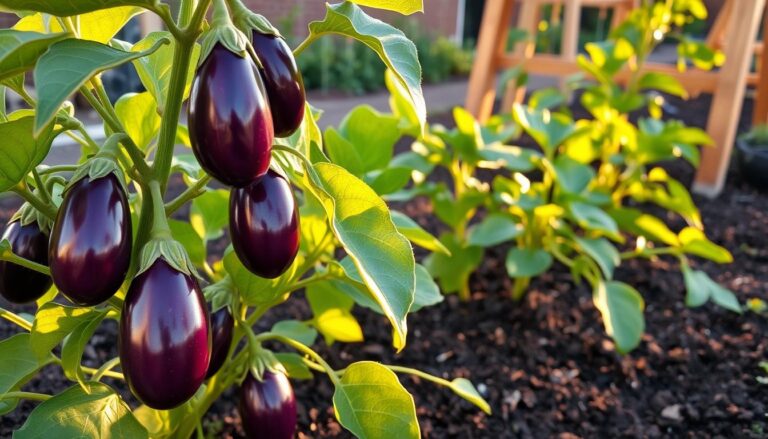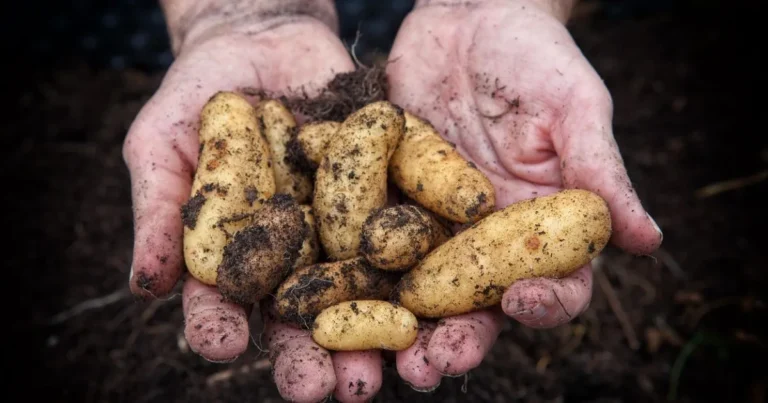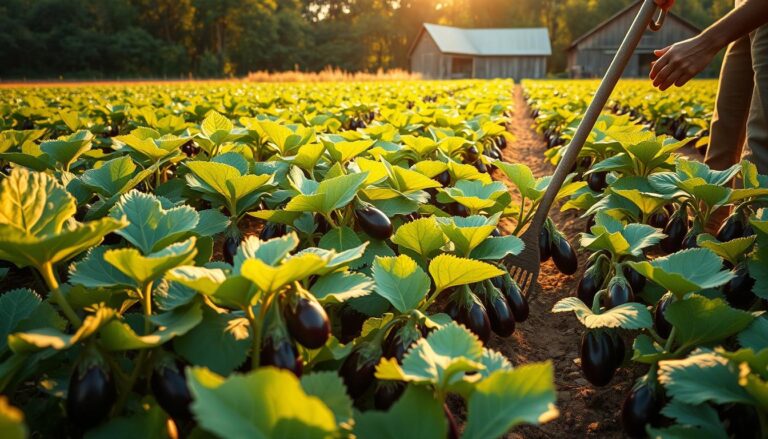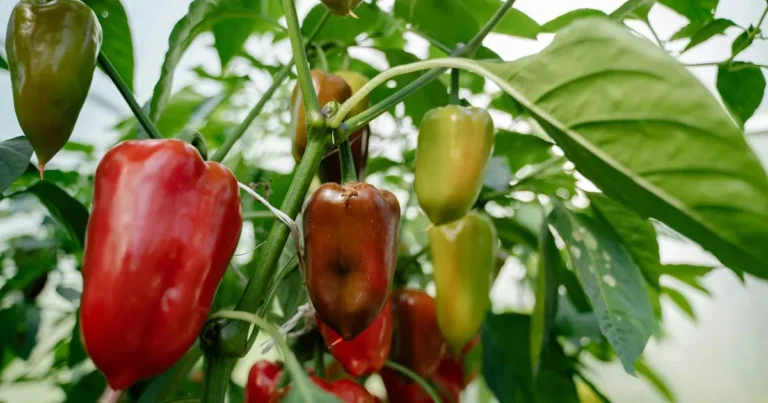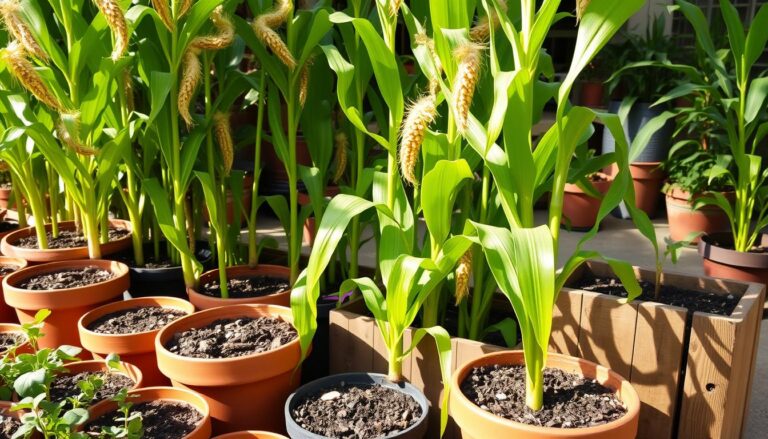Planting Potatoes in Containers: Easy Methods for Home Gardeners
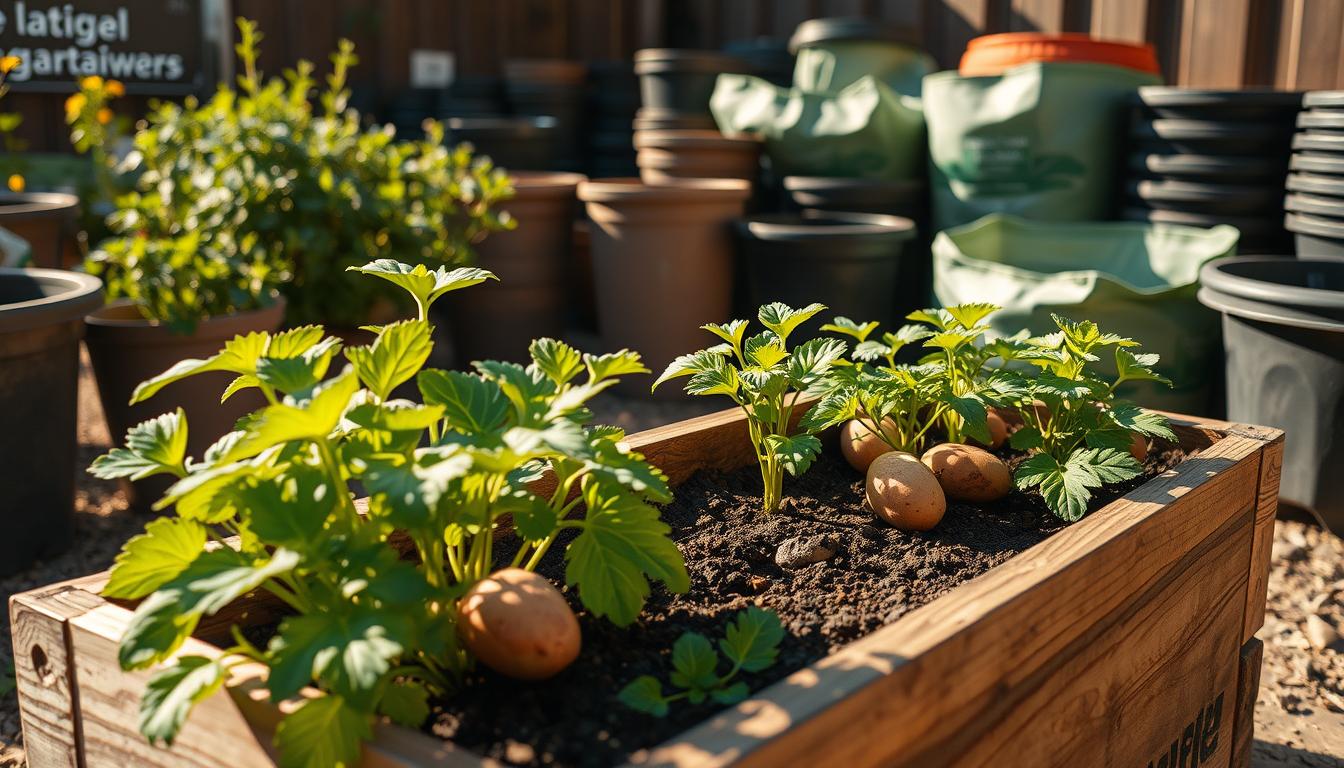
Table of Contents
Planting Potatoes in Containers: Easy Methods for Home Gardeners
You can grow your own potatoes right at home, even with limited space. Using containers for growing potatoes lets you control the growing environment. This can lead to a quicker harvest.
Growing potatoes has never been easier. With containers like 30-liter buckets, you can enjoy a bountiful harvest without a large garden. These containers give the potatoes the space they need to grow. They can be placed in many locations, making it perfect for home gardeners.
By using containers, you can control the soil quality and reduce the risk of pests. This makes it a great option for beginners. This method is not only easy but also rewarding. It gives you fresh, home-grown potatoes.
Why Growing Potatoes in Containers Makes Sense
Potatoes can grow well in containers, giving you a big harvest even in small spaces. This way of gardening is flexible and can be very rewarding.
Benefits for Small Space Gardeners
For those with little space, growing potatoes in containers is perfect. You can use balconies, patios, or small yards for gardening. Plus, you can move the containers to make the most of your space.
Pest and Disease Management Advantages
Container gardening for potatoes helps avoid pests and diseases. You can control the soil quality better, which lowers the risk of contamination. This controlled setting helps keep your plants healthy.
Extended Growing Season Possibilities
Containers can be moved to protect plants from frost or bad weather, extending the growing season. This is very helpful in areas with unpredictable weather.
| Benefits | Description |
|---|---|
| Space Efficiency | Ideal for small gardens and balconies |
| Pest Control | Better soil control reduces pest risks |
| Flexibility | Containers can be moved to protect plants |
Selecting the Right Potato Varieties for Container Growing
When growing potatoes in a container, knowing the different types is key. The right variety can greatly affect your harvest. It’s crucial for a successful potato container garden.
Early Season Varieties
Early season potatoes grow fast, ready in 70-100 days. They’re perfect for containers because you can have multiple harvests. ‘Nicola’ and ‘Red Bliss’ are favorites for their taste and yield.
Mid-Season Varieties
Mid-season potatoes take 100-120 days to grow. They give more yield than early ones but grow a bit slower. ‘Yukon Gold’ and ‘All Blue’ are top picks for this group.
Late Season Varieties
Late season potatoes need 120 days or more to mature. They’re harder to grow in containers because of their long growth time. But ‘Russet Burbank’ is worth it for its flavor and storage.
Specialty and Fingerling Potatoes for Containers
Specialty and fingerling potatoes bring unique tastes and textures. They’re great for adding variety to your harvest. ‘Russian Banana’ and ‘Purple Peruvian’ are excellent choices for containers.
Essential Container Requirements for Successful Potato Growth
Growing potatoes in containers needs the right container for a good harvest. The container you pick affects your potato plants’ health and how well they grow.
Container Size and Depth Considerations
The size and depth of your container matter a lot. Your container should be at least 16 inches high. This lets the roots grow well and tubers form.
A deeper container means you can add more soil. This can lead to a bigger harvest. Use big pots or containers that hold 10-15 gallons of soil for the best results.
Material Options: Plastic, Fabric, Wood, and More
The material of your container can influence potato growth. Plastic pots are easy to move and reuse. Fabric grow bags are great because they let air in and water drain well.
Wooden containers work too, but make sure they’re sealed well to avoid rot.
Drainage Requirements
Drainage is key to stop waterlogged soil. This can cause root rot and diseases. Make sure your container has enough holes at the bottom for water to drain.
You can also add gravel or broken pottery to help with drainage.
Positioning Your Containers for Optimal Growth
Think about where you’ll put your containers. They should get at least 6 hours of direct sunlight. Also, protect them from extreme weather. Good placement is crucial for a successful potato harvest.
By picking the right container and following these tips, you’ll grow great potatoes in containers.
Best Soil Mix for Planting Potatoes in Containers
The secret to growing great potatoes in containers is the right soil mix. You need a mix that drains well and is loose. This helps the roots grow and tubers form.
Ideal Soil Composition
A good soil mix for potatoes should breathe well, hold moisture, and have nutrients. If it’s too dense, it can get waterlogged. If it’s too loose, it might not hold enough water.
pH Requirements
The pH of your soil is very important. Potatoes do best in slightly acidic to neutral soil, with a pH of 4.5 to 7.0. Keeping the pH right helps them absorb nutrients and grow tubers well.
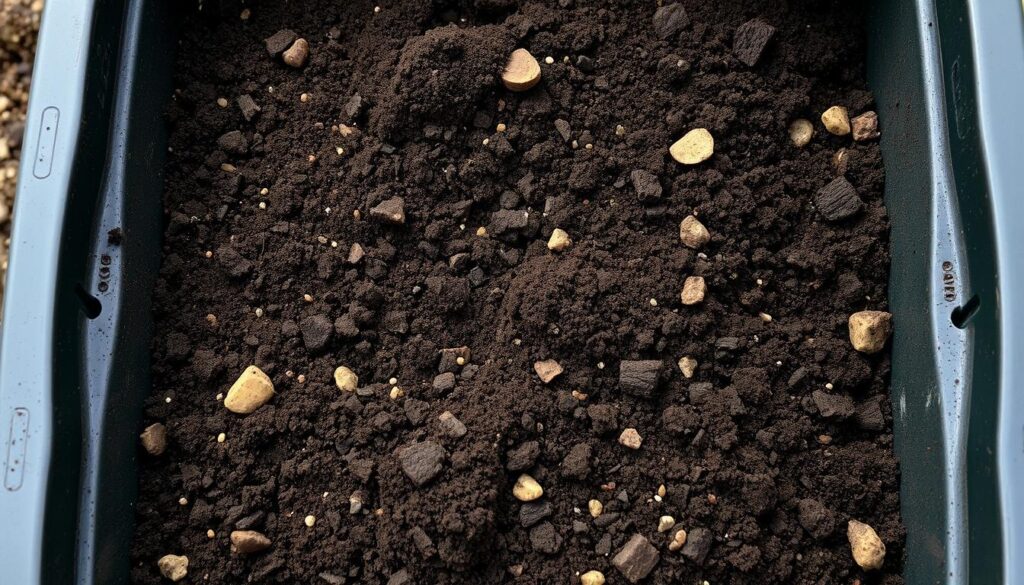
Organic Matter and Amendments
Adding organic matter like compost or manure improves soil. You can also add fertilizers based on your potato variety’s needs.
Commercial vs. DIY Potato Growing Mixes
You can buy a commercial potato mix or make your own. Commercial mixes are easy and meet potato needs. But, making your own lets you tailor it to your container and potatoes.
- Commercial mixes are consistent and weed-free.
- DIY mixes save money and use local materials.
Choosing the right soil mix and keeping conditions perfect will give you a big harvest of tasty potatoes from your container garden.
Preparing Seed Potatoes for Container Planting
Getting your seed potatoes ready is key for a great harvest in containers. This involves a few important steps to help them grow well.
Chitting Process
Chitting seed potatoes 2-4 weeks before planting boosts their growth. Place them with the “eyes” up in a cool, light spot. This helps them sprout before you plant, giving them a head start.
Cutting Larger Seed Potatoes
For bigger seed potatoes, cut them into smaller pieces. Make sure each piece has at least one “eye.” This way, you can use more of your seed and get a bigger harvest.
Treating Cut Surfaces
After cutting, treat the surfaces to stop rot. Let them dry for a few days in a cool, airy spot. This forms a callus, which helps prevent disease when planting in a bucket.
When to Plant for Different US Climate Zones
Planting times vary by climate zone. Plant when the soil is 40°F to 50°F. In warmer areas, this might be late winter. In cooler zones, it’s early spring. Knowing your area’s needs helps your potatoes grow best.
By preparing your seed potatoes right, you’re set for a successful harvest of container-grown potatoes.
Step-by-Step Guide to Planting Potatoes in Container Gardens
To grow potatoes in containers, just follow these easy steps. It’s a fun way to get a lot of tasty potatoes.
Initial Planting Depth
Start by planting your seed potatoes at the right depth. For most containers, 4-6 inches is best. This covers them enough but keeps them close to the top for easy hilling later.
Make sure the “eyes” of the seed potatoes face up. This helps them grow well.
Spacing Requirements
Spacing is key for healthy growth and lots of potatoes. In containers, plant 2-3 seed potatoes, depending on your container size. Space them evenly to avoid crowding.
Leave about 2 inches between each seed potato. This is a good rule of thumb.
Hilling Technique for Container Growing
As your potatoes grow, you’ll need to hill them. Hilling means adding more soil or compost around the plants. Leave just a few inches of leaves showing.
Keep hilling as your plants grow. Gradually add more soil to your container.
Mulching Options for Container Potatoes
Mulching helps keep moisture in, stops weeds, and keeps soil temperature right. Use straw, grass clippings, or compost as mulch. Put on a 2-3 inch layer around your plants, but don’t cover the leaves.
By following these steps and tips, you’ll grow great potatoes in containers. Just remember to water and fertilize them well for the best results.
Watering and Fertilizing Container-Grown Potatoes
To grow potatoes in containers, you need to know how to water and fertilize them. They need consistent care, mainly in moisture and nutrients.
Moisture Requirements Throughout Growth Stages
Keeping the soil evenly moist is key for container-grown potatoes. The soil should be moist but not too wet. In the beginning, keep it moist to help seedlings grow.
As plants grow and start flowering, they need more water. This helps in developing the tubers.
Fertilizer Types and Application Schedule
A balanced fertilizer is vital for potato growth in containers. Choose a fertilizer with an NPK ratio of about 10-10-10. Start fertilizing when plants are 6 inches tall.
Continue fertilizing every 3-4 weeks during the growing season.
Common Watering Mistakes to Avoid
Don’t overwater when growing potatoes in containers. Make sure your container has good drainage. This prevents waterlogged soil, which can cause rot and diseases.
Check soil moisture by feeling it with your finger. If it’s dry up to the knuckle, it’s time to water.
Organic Feeding Options
If you prefer organic methods, compost tea or fish emulsion are great. They provide nutrients and improve soil health.
By following these tips, you’ll have a successful harvest of container-grown potatoes.
Light and Temperature Requirements for Container Potatoes
To grow potatoes in containers, knowing their light and temperature needs is key. They need enough sunlight and moderate temperatures to grow well.
Sunlight Needs
Potatoes need full sun to grow well. Make sure your containers get at least 6 hours of direct sunlight a day. Enough sunlight helps them grow strong leaves and tubers. If your area is too shady, use grow lights to help.
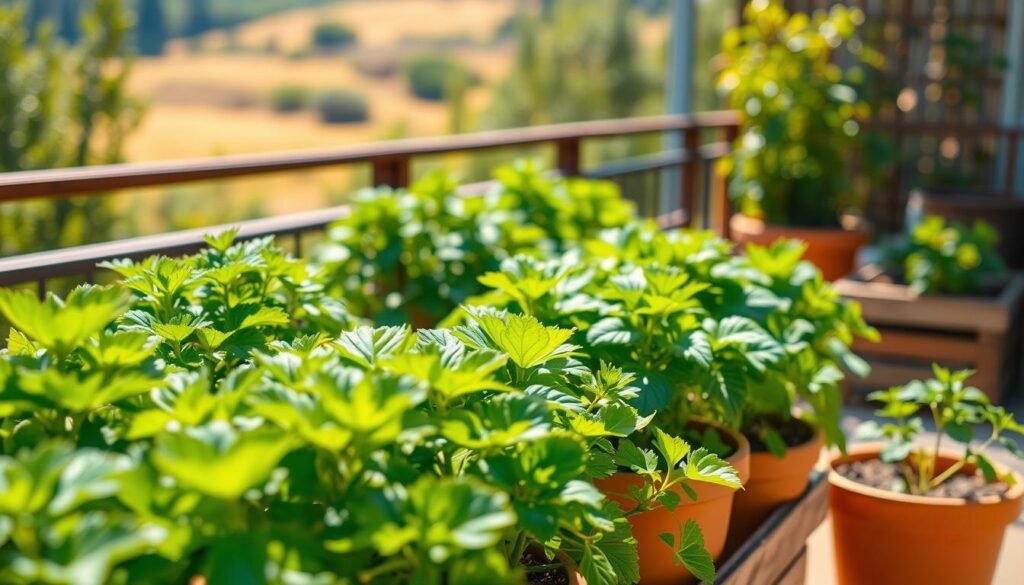
Temperature Considerations
The best temperature for growing potatoes is between 40°F and 70°F (4°C and 21°C). Temperatures outside this range can harm their growth. Cooler temperatures are key when they’re forming tubers.
Seasonal Timing for Different US Growing Zones
In most US zones, spring and early summer are the best times to plant potatoes in containers. In warmer zones (USDA zones 8-10), plant in late winter or late summer. This avoids the hot summer. Check your area’s frost dates to plan.
Protecting Containers from Extreme Weather
To keep your potatoes safe from bad weather, follow these tips:
- Move containers to a safe spot during heavy rain or hail.
- Use row covers or frost blankets to keep out frost.
- Give shade during very hot days, more so in warmer places.
By controlling the weather around your potatoes, you can prevent damage from extreme weather.
Managing Pests and Diseases in Potato Container Gardens
Keeping pests and diseases under control is key for a thriving potato container garden. Growing potatoes in containers comes with its own set of challenges. You face the usual potato growing issues plus the unique aspects of container gardening.
Common Potato Pests and Organic Controls
Aphids and potato beetles are common pests in potato container gardens. To fight them organically, neem oil or insecticidal soap work well. These methods are safe and effective for your garden.
Disease Prevention Strategies
Preventing disease is vital for a healthy potato container garden. Crop rotation and keeping your garden clean can help a lot. Make sure to remove any sick plants to stop disease from spreading.
Signs of Trouble to Watch For
Look out for signs of pests or diseases like yellow leaves, black spots, or white powdery patches. Catching these early is important for managing them well.
Natural Remedies for Common Potato Problems
For common potato issues, natural remedies can help. Copper-based fungicides are good against some diseases. Always read and follow the product instructions for how and when to use them.
Creative Container Ideas for Growing Potatoes
You don’t need a big garden to grow potatoes. Creative containers can thrive in small spaces. Container gardening for potatoes is a versatile and space-saving way to enjoy a bountiful harvest.
Potato Grow Bags
Potato grow bags are a popular choice for growing potatoes. They are flexible and easy to use. These bags are made from breathable materials that promote healthy drainage and aeration, crucial for potato growth. Make sure they have enough drainage holes to prevent waterlogging.
5-Gallon Bucket Method
The 5-gallon bucket method is another effective way to grow potatoes in containers. It’s important to drill enough drainage holes in the bucket to prevent water accumulation. Fill the bucket with a mix of soil and compost, and plant your seed potatoes about 2-3 inches deep.
Stacking Tire System
A creative and eco-friendly option is using a stacking tire system. This method involves stacking tires on top of each other, filling them with soil, and planting potatoes in the layers. As the plants grow, add more tires and soil, creating a tiered effect.
DIY Potato Towers
DIY potato towers offer a customizable solution for growing potatoes. You can create towers using wooden frames or wire mesh cylinders.
Wooden Potato Boxes
Wooden potato boxes provide a sturdy and attractive way to grow potatoes. Make sure the wood is untreated to avoid chemical contamination. The boxes can be of various sizes, but they should be at least 12 inches deep to accommodate the potato tubers.
Wire Mesh Cylinders
Wire mesh cylinders are another excellent option for creating DIY potato towers. They provide excellent support for the plants as they grow and can be easily expanded by adding more mesh and soil.
| Container Type | Depth Requirement | Drainage Needs |
|---|---|---|
| Grow Bags | 12-15 inches | Multiple drainage holes |
| 5-Gallon Buckets | 12-15 inches | Drilled drainage holes |
| Stacking Tires | Variable, depends on tire stack height | Ensure drainage between tire layers |
Troubleshooting Common Issues When Planting Potatoes in Containers
Growing potatoes in containers can be rewarding but comes with challenges. You might face problems that affect your harvest.
Yellowing Leaves
Yellow leaves on your potato plants can mean a few things. Overwatering can cause root rot. Check if you’re watering too much. Also, a lack of nutrients, like nitrogen, can turn leaves yellow. Use a balanced fertilizer to fix this.
Poor Tuber Development
Poor tuber growth can be due to not enough sunlight, not enough soil around the plants, or bad soil. Make sure your plants get at least 6 hours of sunlight. Also, add soil around the plants to help them grow tubers.
Container-Specific Growing Challenges
Growing in containers has its own set of challenges. Keeping the soil at the right temperature and avoiding waterlogged soil are key. Use containers with good drainage and a soil mix made for containers.
Reviving Struggling Container Potato Plants
To save struggling plants, find out what’s wrong and change how you care for them. This might mean watering less, adding nutrients, or improving the soil. With the right care, many plants can get better.
By solving common problems, you can make your container potato garden healthier and more productive.
Harvesting and Storing Your Container-Grown Potatoes
Harvesting potatoes from your container garden is a rewarding experience. It requires some planning and care. To get the most out of your crop, timing your harvest correctly is key. Also, using proper techniques is important.
Timing Your Harvest
The ideal time to harvest your potatoes depends on the variety. Early season varieties are ready about 70 days after planting. Maincrop potatoes take around 100 days or more. Check for readiness by gently digging around the container with your hands or a fork.
Be careful not to damage the tubers.
Techniques for Maximum Yield
To maximize your yield, empty the container’s contents onto a flat surface. Sift through the soil to find all the tubers. Wear gloves to protect your hands from thorns or dirt.
Curing Process for Storage
After harvesting, curing your potatoes is crucial. Cure them in a cool, dark place with good ventilation for about two weeks. This process helps to heal any wounds on the tubers.
Long-Term Storage Methods
For long-term storage, keep your cured potatoes in a cool, dark place. The temperature should be between 40°F and 50°F. Use breathable containers like paper bags or burlap sacks to store them.
Ensure good air circulation to prevent moisture buildup.
Conclusion: Enjoying the Rewards of Container Potato Gardening
Growing potatoes in containers is rewarding. It gives you fresh produce and the joy of gardening in small spaces. By following the guidelines in this article, you’ve learned how to grow potatoes in pots successfully.
Container gardening for potatoes has many benefits. It helps manage pests and diseases better. It also lets you garden in small or unusual spaces. With the right variety, soil mix, and care, your potatoes can thrive.
Now, you can enjoy the delicious potatoes from your container garden. Whether you’re experienced or new to gardening, growing potatoes in containers adds excitement to your hobby.

